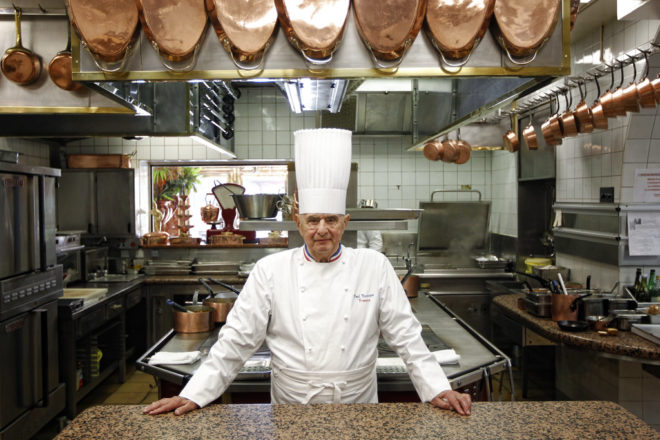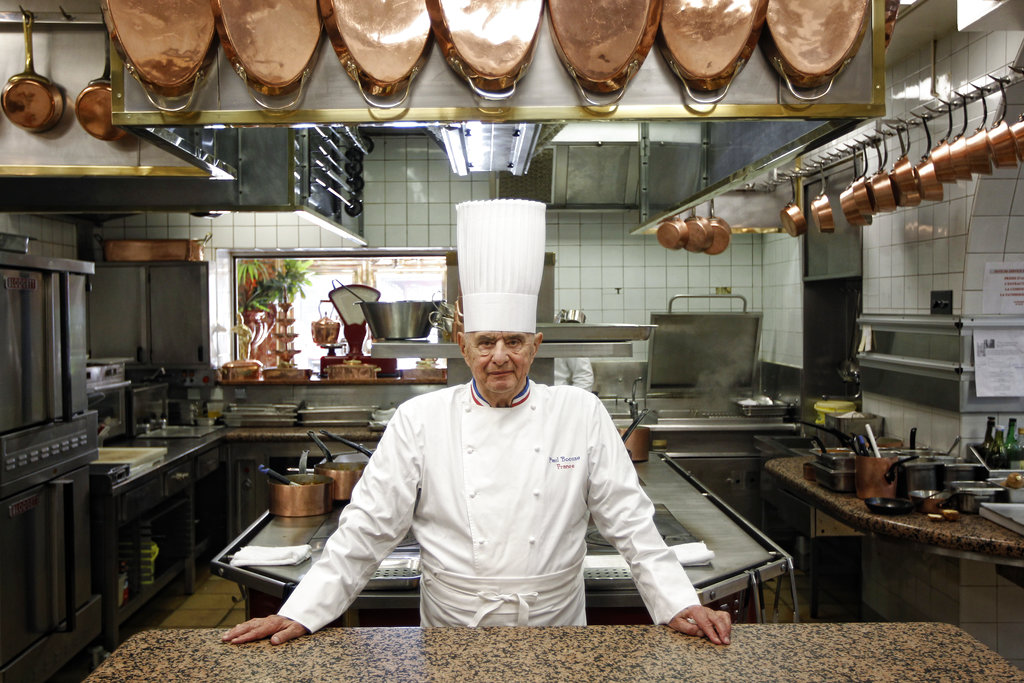
PARIS (AP) — Paul Bocuse, the master chef who defined French cuisine for more than half a century and put it on tables around the world, a man who raised the profile of top chefs from invisible kitchen artists to international celebrities, has died at 91, French officials announced.
Often referred to as the “pope of French cuisine,” Bocuse was a tireless pioneer, the first chef to blend the art of cooking with savvy business tactics — branding his cuisine and his image to create an empire of restaurants around the globe. His imposing physical stature and his larger-than-life personality matched his bold dreams and his far-flung accomplishments.
Bocuse died Saturday at Collonges-au-Mont-d’or, the place where he was born and had his restaurant, French President Emmanuel Macron said in a statement.
“French gastronomy loses a mythical figure … The chefs cry in their kitchens, at the Elysee (presidential palace) and everywhere in France,” Macron said.
Interior Minister Gerard Collomb tweeted that “Mister Paul was France. Simplicity and generosity. Excellence and art de vivre.”
Bocuse, who underwent a triple heart bypass in 2005, had also been suffering from Parkinson’s disease.
Bocuse’s temple to French gastronomy, L’Auberge du Pont de Collonges, outside the city of Lyon in southeastern France, has held three stars — without interruption — since 1965 in the Michelin guide, the bible of gastronomes.
As early as 1982, Bocuse opened a restaurant in the France Pavilion in Walt Disney World’s Epcot Center in Orlando, Florida, headed by his son Jerome, also a chef. In recent years, Bocuse even dabbled in fast food with two outlets in his home base of Lyon.
“He has been a leader. He took the cook out of the kitchen,” said celebrity French chef Alain Ducasse, speaking at a 2013 gathering to honor Bocuse. More than 100 chefs from around the world traveled to Lyon for the occasion — one of a string of such honors bestowed on Bocuse in recent years.

“Monsieur Paul,” as he was known, was placed right in the center of 2013 cover of the newsweekly Le Point that exemplified “The French Genius.” Shown in his trademark pose — arms folded over his crisp white apron, a tall chef’s hat, or “toque,” atop his head — he was winged by Marie Curie, Louis Pasteur and Coco Chanel, among other French luminaries.
While excelling in the business of cooking, Bocuse never flagged in his devotion to his first love, creating a top class, quintessentially French meal. He eschewed the fads and experiments that captivated many other top chefs.
“In cooking, there are those who are rap and those who are concerto,” he told the French newsmagazine L’Express before his 2005 biography, adding that he tended toward the concerto.
In traditional cooking like his, he said, there is no room for guess work.
“One must be immutable, unattackable, monumental,” he declared.
Born into a family of cooks that he dates to the 1700s, Bocuse stood guard over the kitchen of his world-famous restaurant even in retirement, keeping an eye on guests, sometimes greeting them at table.
The red-and-green Auberge by the Saone River, his name boldly set atop the roof, is a temple to Bocuse — who was born there — and to other great chefs. Bocuse waves to arriving guests in a “tromp l’oeuil” painting on an outside wall and peers at them from a large portrait inside the cozy Auberge that once belonged to his parents and remained his home. Renowned chefs, some of whom he worked with, are portrayed in a giant mural.
In a 2011 interview with The Associated Press, Bocuse said he slept in the room where he was born above the dining rooms. “But I changed the sheets,” he added with characteristic wry humor.
Born on Feb. 11, 1926, Bocuse entered his first apprenticeship at 16. He worked at the famed La Mere Brazier in Lyon, then spent eight years with one of his culinary idols, Fernand Point, whose cooking was a precursor to France’s nouvelle cuisine movement, with lighter sauces and lightly cooked fresh vegetables.
Bocuse’s career in the kitchen traversed the ages. He went from apprenticeships and cooking “brigades,” as kitchen teams are known, when stoves were coal-fired and chefs also served as scullery maids, to the ultra-modern kitchen of his Auberge.
“There was rigor,” Bocuse told the AP. “(At La Mere Brazier) you had to wake up early and milk the cows, feed the pigs, do the laundry and cook …. It was a very tough school of hard knocks.”
“Today, the profession has changed enormously. There’s no more coal. You push a button and you have heat,” he said.
Bocuse adapted seamlessly to the changing times, making his mark with a first coveted Michelin star in 1958, a second in 1960 and a third in 1965. Since then, his cooking has been defined by superlatives.
In 1989, Bocuse was named Cook of the Century by Gault & Millau, a noted guidebook. In 2011, the Culinary Institute of America named him Chef of the Century, opening a restaurant for students in his name. He maintained a special pride, however, in the blue, white and red stripes on his chef’s collar holding a large medal, attesting to his selection in 1961 as a “Meilleur Ouvrier de France,” a sought-after distinction for chefs and other artisans.
The gastronomic offerings at Bocuse’s L’Auberge du Pont de Collonges are rooted in the French culinary tradition: simple, authentic food that was “identifiable” in its nature.
Emblematic of that was a crock of truffle soup topped with a golden bubble of pastry he created in 1975 for then-French President Valery Giscard d’Estaing, which is served to this day. Another classic is fricassee of Bresse chicken — from France’s Bresse region, which is famed for its poultry — served in cream with morilles, a spring mushroom.
And his favorite ingredient? Butter.
“(It’s a) magical product,” he said during a visit to the Culinary Institute of America. “Nothing replaces butter.”
Three other cooking must-haves, according to the chef, are fresh produce (his was from his own garden), good, trusted kitchen staff and happy diners.
“It’s the client who runs the house,” Bocuse said in the AP interview.
He disparaged the notion that his culinary offerings amounted to nouvelle cuisine, although he incorporated aspects of it. And he scoffed at critics who contended that his food is stuck in a bygone age. Georges Auguste Escoffier, who gave classic French cuisine a world profile, remains a solid inspiration at Bocuse’s table.
“Escoffier was the master of us all,” Bocuse has said.
World War II interrupted his kitchen duties. He worked in the First Division of the Free French Forces, was wounded and cared for at a U.S. field hospital.
“I always say I have American blood in my veins because … I had transfusions of American blood,” he told the AP. An American flag still flies outside his restaurant.
The war had a lasting impact on the chef.
“(It) forges the character,” he said. “You no longer have the same idea of life.”
Bocuse might have settled for being a renowned French chef worthy of a pilgrimage by food lovers with deep pockets. Instead, he parlayed his culinary skills into a conglomerate of food operations that span the globe and range from haute cuisine to fast food.
He opened two brasseries in Lyon in 1995 and 1997. He added three other eateries in the city and even a hotel. He planted restaurants in the south of France, in Geneva and hopped across the world to Japan, where eight Bocuse brasseries, cafes and other establishments were opened.
But his pride is transmitting his savoir-faire to a young generation through the Foundation Paul Bocuse, established in Lyon in 2004. His Bocuse d’Or, or gold award — an international competition for young chefs — has grown into a major culinary showcase since 1987.
While Bocuse’s kitchens were meticulously in order, his personal life was on the unorthodox side. He acknowledged in a 2005 biography that he had been quietly sharing his life with three women — simultaneously — each with a pivotal role in his life.
“I think cuisine and sex have lots of common points,” Bocuse said before publication of “Paul Bocuse: The Sacred Fire.” “Even if it seems a bit macho, I love women.”
He put an upbeat spin on his private life.
“If I calculate the number of years I’ve been faithful to the three women who count in my life, I get 145 years,” he is quoted as saying in “The Sacred Fire,” which was written by Eve-Marie Zizza-Lalu — daughter of the most recent woman in his life, Patricia, whom he met in 1972.
Yet it is his wife Raymonde, with whom Bocuse had a daughter, Francoise, who helps watch over his restaurant.
Despite accolades from the world of gastronomy, Bocuse saw a restaurant’s reservation book as the real measure of any chef’s talent.
“If the restaurant works, if it’s full of clients … whatever the cuisine, he (the chef) is right,” he said.
He is survived by his wife Raymonde, their daughter Francoise and a son, Jerome. MKH
RELATED STORIES:













































